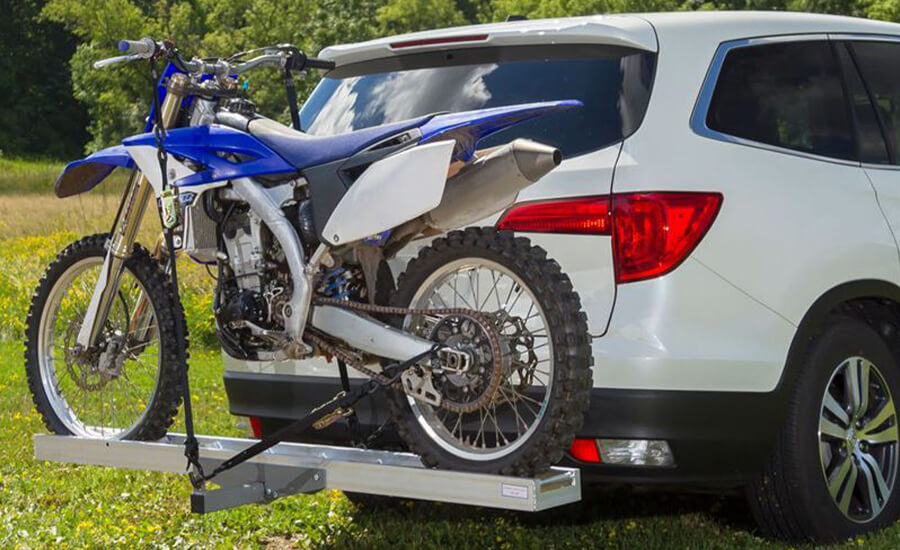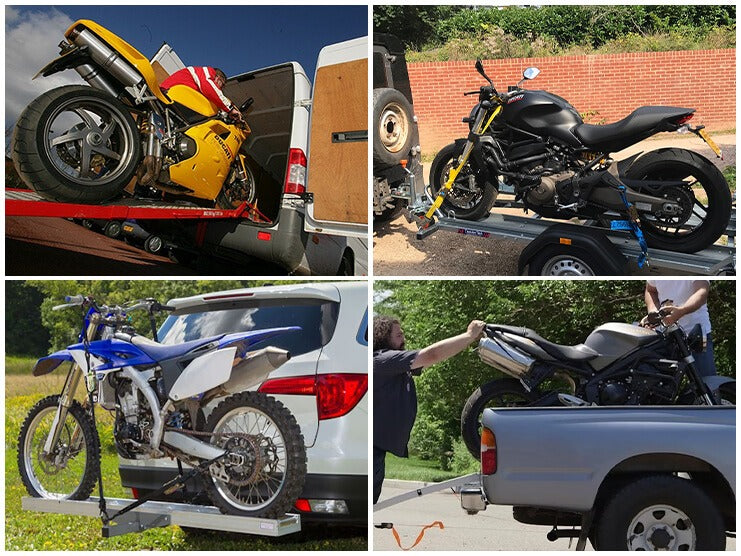Table of Content
Transporting a motorcycle is a common problem many riders face every once in a while. If you need to transport your motorcycle to a different country, then traveling companies are the best option. But what if you like to head up the mountains or go on a long road trip? If you need to transport your motorcycle to an area within a city or between two different cities or states, transporting your motorcycle with a car is the easiest solution. However, there are different ways to transport your motorcycle with a car, each with its own pros and cons. Below are the methods to transport a motorcycle with a car.
1. Moving Van

A van with a large rear space can be used to transport a motorcycle. First, the motorcycle has to be loaded into the van and tied firmly in place to prevent the motorcycle from falling over or sliding around if the van travels over bumpy or rough roads.
| PROS | CONS |
|---|---|
| Motorcycle is protected from weather conditions and being damaged during collision with other vehicles on road. It also safe the motorcycle suspension and tires from being worn out | Not suitable for bigger cruisers or touring motorcycles. Requires bigger vehicle |
| Only motorcycle needs to be loaded and tied down | Difficult to load heavy motorcycle |
| Van does not require extra attachments | Difficult to secure a motorcycle inside a van |
| Riders do not have to pay a traveling company for transporting. The only cost will be paying for fuel | |
| Suitable for carrying light or middleweight motorcycles like DIRT MOTORCYCLES, standard motorcycles, café racers, or lightweight adventure motorcycles |
2. Pickup Truck

Many people who are fond of traveling own a pickup truck. Most pickup trucks have enough space at the back to carry a motorcycle. You will need extra attachments like hooks and wheel holders. The wheel holder is optional, although it can help keep your motorcycle straight and balanced. The hooks clamp onto the edges or the floor of the pickup truck’s rear, helping further secure mounting straps to the motorcycle.
| PROS | CONS |
|---|---|
| Takes little time to load and secure your motorcycle onto the pickup truck | Motorcycle is exposed to rain and bright sunlight unless covered by a protective sheet |
| The only cost is paying for the truck’s fuel when transporting the motorcycle | Requires a higher stand to load motorcycle in a pickup truck |
| Keep motorcycle from being scratched or damaged during collisions | May require more than one person to load the motorcycle |
| Suitable to carry light or middleweight motorcycles like dirt motorcycles, STANDARD MOTORCYCLES, café racers, or lightweight adventure motorcycles |
3. Motorcycle Carrier

Another way to transport a motorcycle is by using a motorcycle carrier. Once you have gotten your preferred type of motorcycle carrier, it can be installed at the back of your vehicle. Your motorcycle can be easily loaded on the carrier and secured in place.
| PROS | CONS |
|---|---|
| An method for those who do not own a pickup truck or a van | Motorcycle will be exposed to rain and harsh sunlight |
| Easy to load and unload the motorcycle on a carrier | Carriers need to be regularly maintained |
| Can be done by one person | Takes time to install and uninstall motorcycle carrier |
| Can easily carry a motorcycle anywhere, especially for vacations and trips | Heavyweight motorbikes like CRUISERS and touring motorcycles will need a more expensive and stronger motorcycle carrier |
| Can carry light or middleweight motorcycles like dirt motorcycles, standard motorcycles, CAFÉ RACERS, or lightweight adventure motorcycles | Motorcycle carriers can break down if the motorcycle is too heavy, the road has rough terrain, or the carrier is made of cheap materials |
| Motorcycle carriers must be purchased separately which can increase travel costs |
4. Tow Dolly
A tow dolly is a small tow s attached to the back of your car, holding up the motorcycle’s front wheel so that it is rolling on its rear wheel. Attaching the front wheel firmly is important to keep the motorcycle. Some people also attach the rear wheel with the tow dolly and roll the motorcycle on the front, which can be done if the rear wheel of the motorcycle is damaged but the handle should be tied firmly so it does not move. However, if there is no emergency case, it is recommended to attach the front wheel.
| PROS | CONS |
|---|---|
| Securing the motorcycle to the tow by only its front wheel saves time | A tow dolly must be bought separately |
| The motorcycle can be quickly loaded and unloaded | Motorcycle is exposed to rain and harsh sunlight |
| Can be used to transport all types of motorcycles | Stiff rear tire and suspensions when hitting bumps in the road |
| Alternative for those who do not own a pickup truck or a van | Can only carry one motorcycle |
| Takes time to install tow dolly |
5. Motorcycle Trailer

A motorcycle trailer allows you to load a heavyweight motorcycle at the rear of your vehicle. A motorcycle trailer has a hook that can be attached to the car and a long stand with an opening for two wheels where your motorcycle can be loaded on.
| PROS | CONS |
|---|---|
| Motorcycles can be easily loaded and unloaded | Motorcycle trailers must be bought separately. |
| All motorcycle parts are better-protected | Motorcycle is exposed to rain and harsh sunlight |
| Suitable for transporting more than one motorcycle | Trailer requires extra space, whether it is on the road or in a garage |
| Suitable for transporting all types of motorcycles | Takes time to install or uninstall the trailer |
| Suitable for transporting motorcycle(s) across long distances between states or cities | |
| Alternative for those who do not own a pickup truck or a van |
6. Important Tips
6.1 Cover the Motorcycle
If the motorcycle is not transported in a van, it is better to cover the motorcycle with a plastic sheet that protects it from external factors like extreme weather conditions.
6.2 Balance the Motorcycle
For all transportation methods, a motorcycle is transported while standing. Therefore, it is better to secure your motorcycle so it is balanced and does not fall towards either side.
6.3 Keep All Tools and Equipment
If the motorcycle is being transported using any other method than a van or a pickup truck, it is better to keep the tools and equipment in case of any emergency with a trailer, carrier, or tow dolly.
6.4 Maintain Motorcycle
It is better to keep the motorcycle well maintained so that it remains in working condition and its parts do not become damaged during and after transportation.
6.5 Good Straps
When transporting your motorcycle, make sure to secure them using strong, good-quality straps to ensure they do not snap and cause the motorcycle to fall and making a disaster.
6.6 Add-Ons
It is recommended you attach extra accessories like SADDLEBAGS, LUGGAGE BAGS, SISSY BARS, and CRASH BARS to provide better comfort and increase storage space.
7. Conclusion
Using a van or a pick truck is convenient if you already own either type of vehicle. However, an average van cannot carry big cruisers and touring motorcycles. The pickup truck is also a good option but may require two people or a longer back depending on the size of the motorcycle. A motorcycle carrier is a reliable alternative for people who do not own a pickup truck or a van, though they are not recommended for carrying heavyweight motorcycles unless you want to risk the carrier breaking. Using a tow dolly is good for transporting all types of motorcycles but the motorcycle rests on its rear wheel which can put a load on the rear suspensions and tires. Transporting a motorcycle with a trailer is ideal for all types of motorcycles but can be expensive.













Leave a comment
All comments are moderated before being published.
This site is protected by hCaptcha and the hCaptcha Privacy Policy and Terms of Service apply.